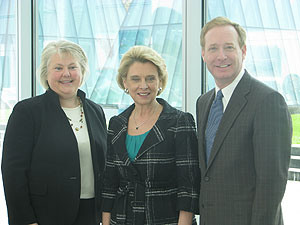REDMOND, Wash. – April 9, 2010 – Microsoft contributed $9.16 billion to the Washington state economy in 2008 through employee compensation and the company’s direct purchases of products and services, according to a Microsoft Economic Impact Study released today. In addition, the company’s total direct and indirect job impact amounted to 267,611 jobs, or 8.4 percent of the total employment in the state.

(Left to Right) University of Washington Law School Dean Kellye Testy, Washington state Governor Christine Gregoire and Microsoft Senior Vice President & General Counsel Brad Smith at an event to share results of the Microsoft Economic Impact study. Seattle, April 9, 2010.
“Microsoft’s ripple effect has been a substantial engine for the state’s economic growth over the last two decades,” said Brad Smith, general counsel and senior vice president, Legal and Corporate Affairs, Microsoft. “Since 1990, Microsoft’s impact has accounted for over 28 percent of the total number of jobs added in Washington state.”
Smith referenced these and other findings from the study at a University of Washington innovation and productivity conference on Friday. The study, conducted by UW Professor Theo Eicher and funded by Microsoft, measures the company’s direct and indirect impact on the Washington state economy.
In 1979, when Microsoft moved to Washington, it was a 30-employee, $3 million-company. In 2008, Microsoft was a 91,000-employee, $60 billion-company still headquartered in Washington, but with offices in 108 countries. The company is currently the second-largest private employer in the state, behind Boeing.
Scott Selby, communications manager in Microsoft Corporate Affairs, further explained the effect of the economic model.
“I think of it as a series of concentric circles,” Selby said. “There are the effects of Microsoft and its business practices, and then you go out and start looking at the economic effect of the company’s employees, partners, and vendors.”
“Microsoft makes money, and then spends some of it on goods and services (the company purchased $2.15 billion in goods and services from Washington producers alone in 2008). That creates additional jobs and growth. Plus, there is then the spending of Microsoft employees as consumers.”

Brad Smith, Microsoft’s general counsel and senior vice president, Legal and Corporate Affairs.
“The economic opportunity created by that total spending can be measured by an ‘employment multiplier,’” Selby said. Typically, companies have multipliers ranging from 2 to 4. Boeing’s multiplier was estimated to be 4 in 2008 and had remained at or near that level for years, according to the Washington Research Council. Microsoft’s multiplier was 4.4 in 1996, and by 2008 it had reached 6.8.
“A healthy Microsoft means a healthy network of partners and vendors, and that really provides far-reaching benefits to the overall community, not just the IT sector,” Selby said.
Eicher notes in the study that it does not include or measure the “positive effects of the philanthropic impact that Microsoft (and Microsoft employees) generate in the state.” Impact studies also don’t take into account “knowledge spillovers produced by the vast number of highly skilled workers that have been attracted to the state either directly or indirectly by Microsoft,” the study said.
To request a full copy of the study, please contact the Waggener Edstrom Worldwide Rapid Response Team or (503) 443-7070.




